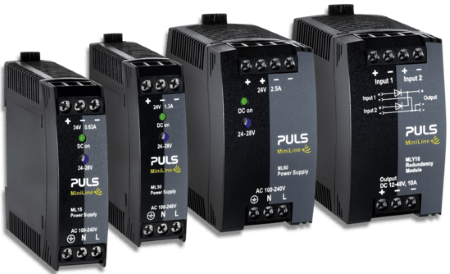No matter who is building your panel, there are many items to consider. Lakewood Automation has the products you need and the tools to make your panel build a successful one. Before you get overwhelmed by all the options, checklist of items that normally go within a panel and a guide on how to select those components. The control system - HMI and PLC are intentionally left out, those are up to you, but we are always able to help if needed.
Picking out a power supply is just one of many important aspects of designing a panel. Here are the things you should consider:
Input Voltage
Typical input voltages are single phase, 120 and 240 VAC. Some other possible input voltage choices, more so for specific applications, may include single-phase or three-phase, 480 VAC, 24 VDC or 90-350 VDC.

Output Voltage
The most common output voltage you'll run across is 24 VDC. There other options, which include but are not limited to 5 VDC, 12 VDC, 15VDC, 36 VDC or 48 VDC.
Wattage/Amperage
Most manufacturers list their output in watts. The higher the wattage, the more power it can supply. Wattage goes hand in hand with amperage as the amperage multiplied by the voltage equals the wattage.
Physical Dimensions
Another important characteristic is the physical dimensions of the power supply. One thing to keep in mind is the amount of cabinet space you have when picking out a power supply. Manufacturers are specializing in making smaller, just as powerful as larger, power supplies to save on cabinet space. The smaller power supplies also produce less heat than in the past!
Efficiency
In short, efficiency is output power divided by input power. The more efficient the power supply is, the less wattage is wasted as heat. Multiple advantages come to mind when talking about efficiency, including cost of the power, reliability and longevity. Peak efficiency is around 92% and up, which is obtained by all of the power supply lines we carry. This threshold will continue to climb until the ultimate goal of 100% efficiency.
In today's control cabinets devices communicate rapidly, many of those devices are using a Ethernet/IP network. Even if your devices are not connected to the internet, Ethernet switches are still widely used for device to device communication.
What to consider when picking out an Ethernet switch:
Managed vs Unmanaged
In other words, a managed switch can be configured to preform various tasks like adjusting speeds, monitoring traffic and report activity. An unmanaged switch requires no setup, just plug in the cables and supply power.
Number of Ports
How many devices need connecting? Make sure the switch has enough ports plus 1 for the engineering computer.
Mounting and Size
Note the size and mounting style of the switch to make sure it will fit in the panel and work with the dinrail.
Specifications
For industrial applications switches should meet IEC61850 requirements for power transmission and distribution. If the unit will have interaction with hazardous materials additional specifications may be required. The temperature range the switch will be subjected to is also important. Be sure to reference the data sheet.
Communication
Here there are again a few standards for communication, at a minimum they should be compliant with Standard IEEE.
LAN specifications for 10BaseT or 100BaseT, 1000BaseT - should be reviewed with the devices that are intended to be connected. This also plays into transmission speed.
What in enclosure?
An enclosure is a cabinet specially made for automation environments and control systems. It protects electronic equipment from the environment. It also protects people from the hazard of electric shock.
Sizing the panel
In order to select the right size panel the bill of material needs to be completed before ordering. Electrical drawings are usually generated first, then the bill of materials and finally the panel layout of all the hardware. This is a service Lakewood Automation can provide!
Don't forget to check if the panel includes the backplane! This is the piece of material that gets secured in the back of the cabinet and holds all of the components. Some companies sell the backplane separately.
Door Layout
The door usually hinges on the left, there should always be three feet of clearance in front of the enclosure per NFPA. Some panels allow the user to pick the door side, others do not.
NEMA ratings and material
There are multiple options available when it comes to control cabinets, making sure you have right cabinet rating for the job is important. NEMA has a great reference chart for this. Material wise the options are mild steel, stainless and fiberglass among other. The material should be selected per the environmental conditions.

